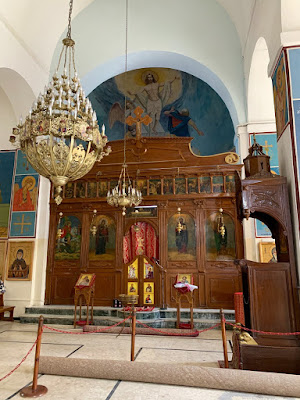This is the place Elijah ascended to heaven in the 9th century BC - at the arch in the above pic. In the Bible in 2 Kings 2 it reads as follows: As they were walking along and talking together, suddenly a chariot of fire and horses of fire appeared and separated the two of them, and Elijah went up to heaven in a whirlwind. Elisha saw this and cried out, "My father! My father! The chariots and horsemen of Israel!" And Elisha* saw Elijah no more. Then he took hold of his garment and tore it in two.
*Elisha was a disciple of the prophet Elijah
The Bible states that Elijah would return before the coming of Jesus, so when John the Baptist began baptizing people in the Jordan, it caused a huge stir in the surrounding villages. In Matthew 3:11, John responded... "I baptize you with water for repentance. But after me comes one who is more powerful than I, whose sandals I am not worthy to carry. He will baptize you with the Holy Spirit and fire."
Jesus, the Messiah foreshadowed in the above passage, did indeed come to the Jordan from Galilee to see John the Baptist, where he was baptized. In verses 16-17 of this same chapter in Matthew, it reads as follows: As soon as Jesus was baptized, he went up out of the water. At that moment heaven was opened, and he saw the Spirit of God descending like a dove and alighting on him. And a voice from heaven said, "This is my Son, whom I love; with him I am well pleased."
What an amazing sight that must have been! It was declared a UNESCO World Heritage sight in 2015 as the place where Jesus was baptized and a pilgrimage site throughout history for Christians. The site includes a variety of modern day churches of different denominations, a monastery, baptismal pools, hermit cells, a pilgrim's station and the cave where John the Baptist may have lived.
Above is the now covered remains of a church from the 5th century, with a separate baptistry that used the water of the Jordan for baptism. That's in the three pictures below.
There is a cross carved into the stone down close to the bottom of the old baptism entry steps - do you see it? Below is the the modern stretch of the Jordan River where baptisms are currently held. Looking across from the Jordan side, you can see Israel on the opposite bank. The border between the two countries is in the middle of the river and you can just make out a long yellow floating line where it exists. On the Jordan side, there were few tourists. But across on the Israel side, we saw a couple folks being baptized despite the fact that the air temp wasn't quite 60F. That would have been a cold dunking!
Our next stop was historic Mt Nebo and another amazing biblical connection. After 40 years of leading the headstrong Israelites in the desert, Moses stood on the windswept summit of Mt Nebo and viewed the promised land of Canaan. In Deuteronomy 34 it reads: Then Moses climbed Mt Nebo... there the Lord showed him the whole land... Then the Lord said to him, "This is the land I promised on oath to Abraham, Isaac and Jacob when I said, 'I will give it to your descendants.' I have let you see it with your eyes, but you will not cross over into it." And Moses the servant of the Lord died there and was buried.
On a clear day, pilgrims and tourists can see the panorama Moses viewed, including the Dead Sea, the Jordan River valley, Jericho, Bethlehem, and the distant hills of Jerusalem.
Below, daughter A and I stood next to the modern serpentine cross sculpture. This is another biblical reference from the Old Testament about Moses. The sculpture resembles Moses' staff that produced water from a rock, turned into a snake and was used to part the Red Sea, all at God's will since He chose Moses to serve His purposes for the Israelites. The artist adapted the staff and serpent into a cruciform shape.
Atop Mt Nebo we toured some amazing mosaic floor remains. Early Christians from Jerusalem made Mt Nebo a place of pilgrimage. In the 3rd and 4th centuries, monks from Egypt built a small church to commemorate the life of Moses. This church was expanded in the 5th and 6th centuries into a large basilica with a stunning collection of Byzantine mosaics and an elaborate baptistry. These mosaics are now housed in a building with some catwalks so that you are able to get a good look at them. The main large mosaic depicts monastic wine-making, hunters and various animals.
The final stop of our long driving day was at the Greek Orthodox Church of St George in old Madaba. This is the site of the famous mosaic floor map of the middle east during biblical times.
This tile map is the oldest known geographic floor mosaic in existence, depicting the Middle East during the height of the Byzantine period. Installed sometime during the 6th century, many of the map's tiles have been chipped away or destroyed.
































No comments:
Post a Comment